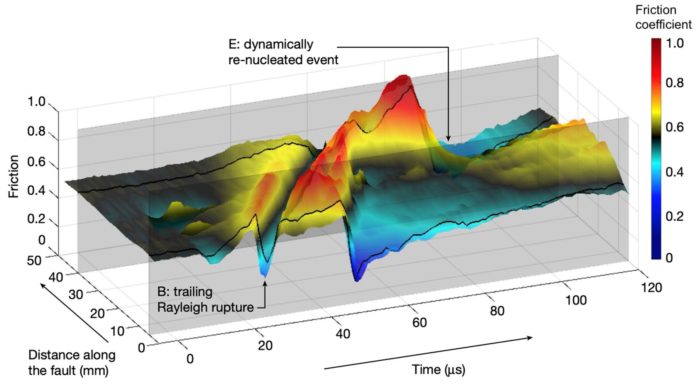Engineers at Caltech have used earthquake simulations in the lab to provide significant experimental support for a type of seismic propagation now assumed to be responsible for the magnitude-9.0 earthquake that ravaged Japan’s coast in 2011.
As tectonic plates grind against one another, fine-grained gravel forms along fault lines, which are the boundaries of tectonic plates. The impact of this gravel on earthquakes has long been a source of debate among scientists. Caltech researchers illustrate in a new report published in the journal Nature that tiny gravel, known as rock gouge, first stops earthquake propagation but later triggers seismic rebirth, resulting in severe ruptures.
“Our novel experimental approach has enabled us to look into the earthquake process up close, and to uncover key features of rupture propagation and friction evolution in rock gouge,” explains Vito Rubino, lead author. “One of the main findings of our study is that fault sections previously thought to act as barriers against dynamic rupture may in fact host earthquakes, as a result of the activation of co-seismic friction weakening mechanisms.”
Previously thought to be “immune” to major ruptures due to their “stable” or “creeping” nature, the Lawrence A. Hanson Jr. Professor of Mechanical Engineering and Geophysics and Theodore von Kármán Professor of Aeronautics and Mechanical Engineering, Rubino and his co-authors show that this is not the case. When tectonic plates move gently past each other without causing major earthquakes, these faults form (for example, the currently creeping section of the San Andreas Fault in central California).
Rock gouge, on the other hand, has a complicated behavior. It works as an initial line of defense against the rupture, collecting energy and preventing it from spreading. The rock gouge interface degrades and drastically reduces friction between the two plates when the plates glide past each other at a high enough velocity, causing the quake to resurface. Renucleation is the term for this process.
“We know that rock gouge can either strengthen with fault slip and act as a barrier, or weaken and promote earthquake rupture,” Lapusta says, citing a large body of past rock-friction tests. “However, these behaviors are typically considered to be separated in space, with weakening and strengthening occurring on different fault locations. Our experiments show how these behaviors can combine on the same fault locations during the same slip event, over the timescales of dynamic rupture, leading to intermittent slip and potentially turning a fault barrier into an earthquake-prone region .”
The research published in Nature investigates the role of rock gouge, a granular substance with dimensions of micrometers and larger, and how it responds to seismic activity. The researchers used Caltech’s so-called seismological wind tunnel, which was established by Rosakis and former Caltech Seismological Laboratory head Hiroo Kanamori, John E. and Hazel S. Smits Professor of Geophysics, Emeritus, to mimic the influence of rock gouge on earthquake propagation. Engineers and scientists can use the facility, which has been around since 1999, to investigate large earthquakes at a size that is more manageable for them.
To create an earthquake simulation, the team first sliced a translucent meter-sized block of Homalite in two. Dynamic rupture nucleation can occur in samples as tiny as tens of centimeters in diameter, whereas examining same phenomena in rock would necessitate samples of tens of meters in size.
The researchers next applied tremendous pressure and shear to the two sides of the Homalite, replicating tectonic pressure that builds up along a fault line. As a stand-in for fault gouge, fine-grained quartz powder was inserted between the pieces. The scientists then placed a short wire fuse between the two pieces, the “epicenter” of the earthquake they were simulating. High-speed imaging technology was utilized to document the progression of the simulated earthquake one millionth of a second at a time as it developed.
“Back in the late 1990s, when we were designing the ‘seismological wind tunnel,’ we could never have imagined its success in discovering such a rich spectrum of physical phenomena relating to frictional earthquake source processes and that such phenomena could rigorously be scaled to explain natural earthquake behavior occurring at massively different length scale around the globe,” adds Rosakis. “This is a testament of the tremendous power of the discipline of mechanics.”
Researchers are now looking into how fluids, which are naturally present in the Earth’s crust, affect friction in rock gouging.
Image Credit: Getty
You were reading: New Study Reveals What Caused Magnitude-9.0 Earthquake In Japan
